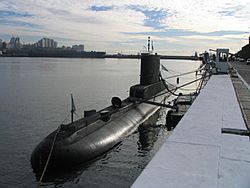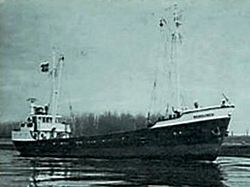Argentine naval forces in the Falklands War facts for kids
The Argentine naval forces in the Falklands War played a big part in the conflict. This article tells you about the ships and sailors involved. If you want to know about the British ships, you can look up British naval forces in the Falklands War.
Contents
Background
The Argentine Navy (ARA) was a key group that wanted to solve the long-standing argument over the Falkland Islands with military action. By 1982, Argentina was facing tough economic times. Admiral Jorge Anaya, a leader in the government, decided to start "Operation Rosario" early, on April 2. This happened after some Argentine military members, pretending to be scrap metal workers, raised the Argentine flag on South Georgia on March 19.
General Galtieri, who was the acting president, agreed to a quick takeover of the islands. The plan was to occupy them, then pull most troops out. A small group would stay to support a new governor. This was meant to make the UK start talks about who owned the islands. On April 2, Argentine forces landed at Stanley. The next day, April 3, Argentine marines used helicopters to take over South Georgia. The Argentine leaders were moving their troops back home. But then, the British reacted by getting a large naval force ready. They planned to take the islands back by force.
The war came at a difficult time for Argentina. They were waiting for new warships and submarines from West Germany. Also, their new French Super Étendard planes and Exocet missiles were not yet fully delivered.
Operation Rosario (April 2)
This was the main operation to take control of the Falkland Islands. Vice Admiral Juan Lombardo was in charge.
Task Group 20
Commander José Sarcona led this group, which acted as a covering force.
- ARA Veinticinco de Mayo – This was an aircraft carrier, like a floating airport for planes.
- ARA Comodoro Py – A destroyer, a fast warship.
- ARA Comodoro Seguí – Another destroyer.
- ARA Hipólito Bouchard – A destroyer.
- ARA Piedrabuena – A destroyer.
- ARA Punta Médanos – A tanker ship, used to carry fuel for other ships.
Task Group 40
Rear Admiral Jorge Allara led this group, which was the amphibious force. This means they carried troops and equipment for landing on shore.
- ARA Santísima Trinidad – A destroyer and the flagship (where the commander was).
- ARA Cabo San Antonio – A large landing ship (LST) that could carry tanks and vehicles.
- ARA Hércules – Another destroyer.
- ARA Granville – A corvette, a smaller warship.
- ARA Drummond – Another corvette.
- ARA Almirante Irízar – An icebreaker ship.
- ARA Santa Fe – A submarine.
- ARA Isla de los Estados – A supply ship.
South Georgia (April 3)
Argentine forces also took control of South Georgia Island.
- ARA Guerrico – A corvette. One person died on this ship.
- ARA Bahia Paraiso – An Antarctic survey ship. It later became a hospital ship. This ship carried Argentine forces to South Georgia before the war started.
Falklands Theatre of Operations (April 2 – June 14)
This was the main area where naval battles happened around the Falkland Islands.
- ARA Alferez Sobral – A patrol vessel. It was damaged by Sea Skua missiles from British helicopters. Eight people died on board.
- ARA Comodoro Somellera – A patrol vessel. The British first thought they sank it, but later found it was still afloat. It served until 1998.
- ARA Isla de los Estados – A transport ship. It was sunk by a British warship in Falkland Sound. Twenty-two people died.
- ARA Bahía Buen Suceso – A transport ship. It carried the group that started the Falklands War to South Georgia. It was later damaged by British planes and captured after the war. The British then sank its hull.
South Atlantic Theatre of Operations (April 15 – June 14)
This covered a wider area of the South Atlantic, controlled from the Puerto Belgrano Naval Base. Vice Admiral Juan Lombardo was in charge.
Task Group 79.1
Rear Admiral Jorge Allara led this group.
- ARA Veinticinco de Mayo – The aircraft carrier. It stayed in port after May 3 because of the threat of submarine attacks.
- ARA Hércules – A destroyer.
- ARA Santísima Trinidad – A destroyer.
- ARA Punta Médanos – A fleet tanker.
Task Group 79.3
Captain Héctor Bonzo led this group.
- ARA General Belgrano – A cruiser. It was sunk by torpedoes from the British submarine HMS Conqueror. Three hundred and twenty-three people died.
- ARA Hipólito Bouchard – A destroyer.
- ARA Piedrabuena – A destroyer.
- ARA Punta Delgada – A fleet tanker.
Task Group 79.4
Captain Juan Calmon led this group.
- ARA Drummond – A corvette.
- ARA Guerrico – A corvette.
- ARA Granville – A corvette.
Submarine force
- ARA San Luis – A submarine.
- ARA Santa Fe – This submarine was damaged at Grytvyken by missiles from British helicopters. It was later sunk by the British in 1985. One person died.
Others
- ARA Almirante Irízar – This ship acted as a hospital ship.
- ARA Francisco de Gurruchaga – A patrol ship.
Argentine Coast Guard
The Coast Guard also had ships in the area.
- Islas Malvinas – A patrol boat. It was damaged by machine gun fire from a British helicopter. It was captured by the British on June 14, 1982.
- Río Iguazú – A patrol boat. It was attacked and damaged by British planes while carrying guns. It was later captured by British forces. One person died.
Regular cargo ships and fishing boats also played a role in the war.
Blockade runners
These ships tried to get supplies past the British blockade.
- Formosa – A large cargo ship. It was accidentally attacked by Argentine planes but survived the war.
- Río Carcarañá – A cargo ship. It was damaged by British planes and later sunk by missiles.
- Yehuín – An oil tender (a small ship that supplies others). It was captured by the British.
- Río Cincel – A cargo ship that survived the war.
- Mar del Norte – A cargo ship that survived the war.
- Lago Argentino – A cargo ship that survived the war.
- Puerto Rosales – A commercial tanker that survived the war.
Spy trawlers
These were fishing boats used to gather information about British ships.
- Narwal – A fishing trawler. It was damaged by British planes and later captured. One crew member died. It sank in a storm.
- María Alejandra – A fishing trawler. It helped the damaged ARA Alférez Sobral and acted as a radio link.
- Constanza – A fishing trawler.
- Invierno – A fishing trawler.
- Capitán Canepa – A fishing trawler.
- María Luisa – A fishing trawler. It spotted a British warship, helping Argentina learn about the British fleet.
- Usurbil – A fishing trawler. It made radar contact with British ships.
- Mar Azul – A fishing trawler. It tracked British ships by radar.
- Río de la Plata II – A cargo ship. It was a very successful spy ship, gathering important information about British warships and supply ships.
The Argentine Navy also took control of some ships belonging to the Falkland Islands Company.
- Forrest – An armed coaster (a small cargo ship). It fought off a British helicopter and rescued survivors from a sunken Argentine ship. It also helped supply troops.
- Monsunen – An armed coaster. It survived an attack by British warships by running aground. It was later recovered by British forces.
- Penelope – A schooner (a type of sailing ship). It was seized by an Argentine crew and used for supplies. It survived a naval attack.
See also
- Argentine air forces in the Falklands War
- Argentine ground forces in the Falklands War
- List of ships of the Argentine Navy
|




